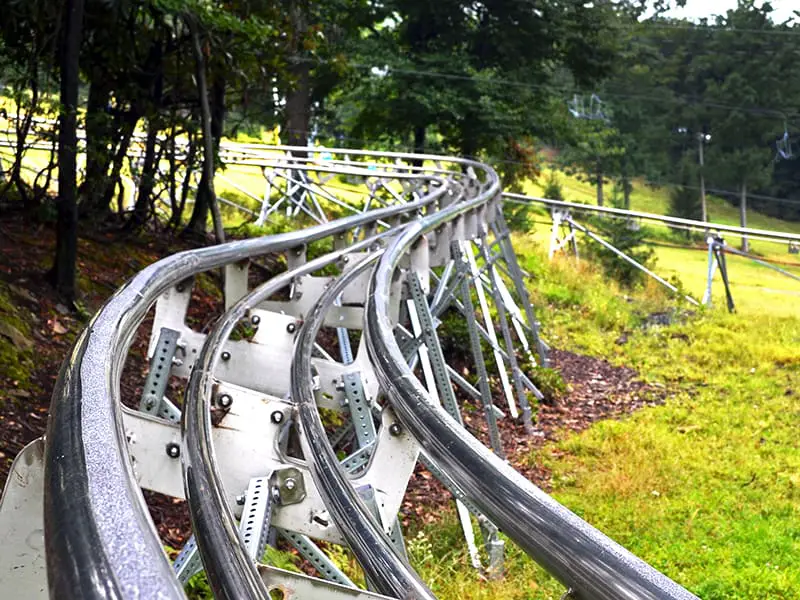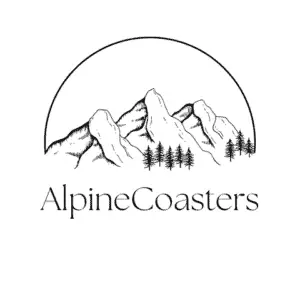Alpine and mountain coasters are gaining in popularity around the world and this doesn’t surprise us at all.
Located in some of the most beautiful settings, alpine and mountain coasters are a great outdoor activity that the whole family can enjoy!
In this article, we explain exactly what mountain and alpine coasters are and we address some of the most common questions we receive.
Contents
- What Is An Alpine Coaster?
- Mountain and Alpine Coasters: A Brief History
- Why You Should Ride An Alpine Coaster
- Are Alpine Coasters Safe?
- How Fast Can You Go On An Alpine Coaster?
- Can You Control the Speed Of An Alpine Coaster?
- Do Alpine Coasters Have a Weight Limit?
- Do Alpine Coasters Run in the Rain?
- Do You Have To Use the Brakes On a Mountain Coaster?
- Can You Go Slow On a Mountain Coaster?
- Can You Wear Flip-flops On Mountain and Alpine Coasters?
- Can Two People Ride an Alpine Coaster?
What Is An Alpine Coaster?
An alpine coaster (also known as a mountain coaster) is a type of roller coaster found in mountainous areas such as ski resorts. Riders sit in a cart, similar to a bobsled, that is attached to a fixed track. Alpine coasters use the natural elevation of the area and gravity to transport riders down the mountain.
A unique feature of alpine coasters is that, unlike traditional roller coasters, they have a manual brake that enables riders to control the speed of their descent.
As a rider, this means that you are in control of your experience.
To give you a sense of the tracks an alpine coaster runs on take a look at the image below.

We can write as much as we want about alpine and mountain coasters but the best way to get a feel for the experience is to watch a video from the driver’s seat.
We’ve selected two videos below that we hope to inspire you to get out and experience an alpine coaster for yourself.
No better place to start than with one of the longest alpine coasters in the world – the Tobotronc at Naturlandia in Andorra.
It covers 3.3 miles (5.3 km) and has an elevation drop of 1,312 feet (400m). It descends through the La Rabassa Forest in a ride lasting more than five minutes.
And for something a little different how about the Park City Mountain Coaster in Utah during winter?
Mountain and Alpine Coasters: A Brief History
The alpine coaster has its origins in Germany.
The company that developed the alpine coaster, Wiegand Sports GmbH, started off by installing alpine slides.
The founder of Wiegand, Josef Weigand, had the idea of creating a roller-coaster-type product for ski areas that would take advantage of the natural elevation of the terrain.
This was an alternative to building the fixed structure that a traditional roller coaster requires to create the elevation.
In 1997 the first alpine coaster was developed and installed.
Since then, the alpine coaster has become a very popular attraction at many ski resorts and other mountain destinations around the world.
Why You Should Ride An Alpine Coaster
Alpine coasters are unique in that they are essentially a roller-coaster built on the side of a mountain.
As a rider you are able to enjoy the thrill of a roller-coaster while being outdoors, surrounded by beautiful views and fresh mountain air.
Unlike traditional roller coasters, alpine coasters have a manual brake (in addition to other safety features) that allows riders to control the speed of their descent.
If you enjoy an adrenaline rush, but also like to have some control over how fast you’re going, then an alpine coaster is the perfect activity for you.
Alpine coasters also have a capacity for two people. This makes it a great family activity as almost everyone over the age of 3 can take part in this ride.
The age and height restrictions for alpine coasters vary but on average we have found the following to be a good guide:
- Ride alone: minimum height of 56 inches (142 cm) and a minimum age of 8 – 9 years old.
- As a passenger: minimum age 3 years old with a minimum height of 28 inches (72cm). The person driving the cart must be at least 16 years or older.
- Maximum weight (per cart): 375 pounds (170kg)
Are Alpine Coasters Safe?
Modern alpine coasters include a number of key safety features that ensure passengers have a safe and enjoyable ride.
Below is a breakdown of these features and how they contribute to your safety:
1. Belt Systems
Alpine coasters have individual belt systems (for both passengers) and belt-locking devices to ensure passengers are held securely in their seats.
2. Manual brake and Centrifugal Brake
Unlike roller coasters, all alpine coasters are fitted with a manual brake. This enables riders to adjust the ride to a speed they feel comfortable with.
In addition to the manual brake, the cart is fitted with a centrifugal brake which limits its maximum speed to approximately 27 mp/h (43 km/h).
It does this by limiting the rotational speed of the running wheels.
This means that even if the rider does not use the manual brake the cart cannot go above a certain speed ensuring maximum safety for its occupants.
3. Braking system at the end
Alpine coasters are also fitted with an automatic braking system that slows the cart down at the end of the track.
4. Distance Control
Distance control is an optional anti-collision feature added to modern alpine coasters. This safety feature automatically slows an alpine coaster if it gets too close to the one ahead.
5. Following the Rules
As with all rides of this nature, it is important that riders follow the rules to ensure their safety.
This means adhering to the weight and height restrictions and wearing the safety belt at all times.
Alpine coasters are high-speed, thrilling rides with multiple twists, jumps and turns. All the safety features listed above are there to ensure your ride is as safe and enjoyable as possible.
How Fast Can You Go On An Alpine Coaster?
The maximum speed you can go on an alpine coaster is between 25-27 mp/h (40-43 km/h).
Although some alpine coasters could probably go a lot faster, the carts are fitted with an automatic braking system that sets a maximum speed limit.
The speed limit is there to ensure the safety of the riders.
Can You Control the Speed Of An Alpine Coaster?
The speed of an alpine coaster can be controlled by the rider.
This is one of the most unique features of alpine coasters and something that separates them from normal roller coasters.
Each alpine coaster is fitted with a manual brake, a lever on the side of the cart or between the rider’s legs, that allows the rider to adjust the speed of descent.
This makes alpine coasters a family-friendly ride because everyone is able to enjoy the ride at a speed that is comfortable for them.
Just remember that each cart is fitted with an automatic braking system that sets a maximum speed and slows that cart down at the end of the track.
Do Alpine Coasters Have a Weight Limit?
All alpine coasters have a weight limit to ensure maximum safety for the riders.
Maximum weight limits are usually 375 lbs (170kg) in dry conditions and 335 lbs (152kg) in wet conditions.
The weight limit referred to above is the combined weight in the cart. Most alpine and mountain coaster carts have the capacity for two people.
Do Alpine Coasters Run In the Rain?
Almost all alpine coasters can operate in the rain.
If it is raining, protective covers are attached to the alpine coaster to make the ride experience more enjoyable.
For safety reasons, alpine coasters will not operate in thunderstorms or heavy rain.
Do You Have To Use the Brakes On a Mountain Coaster?
You do not have to use the brakes on a mountain or alpine coaster.
All mountain and alpine coasters are fitted with a manual brake that enables the driver to control the speed of their descent.
This brake is optional and only needs to be used if the rider feels the need to slow down.
However, if you choose not to use the manual brake, the carts also have an automatic braking system that slows that cart down when it reaches a maximum speed.
The maximum speed ranges from 25-28 mp/h (40-45 km/h).
Can You Go Slow On a Mountain Coaster?
Yes, you can go slow on a mountain coaster because mountain and alpine coasters have manual brakes which allows you to control your speed.
This is one of the features that separates mountain and alpine coasters from regular roller coasters.
For your and other riders’ safety, we recommend that you don’t go too slowly on the track.
The rider behind you might be going a lot faster and this could result in a potential collision.
Can You Wear Flip-flops On Mountain and Alpine Coasters?
The general recommendation is that you cannot wear flip-flops, Crocs, or sandals on mountains and alpine coasters as these are loose items that could fall off during the ride.
Most venues will require all riders to wear closed shoes.
Can Two People Ride the Alpine Coaster?
Yes, alpine and mountain coasters have the capacity for up to two riders.
However, given the size of the carts, it can be cramped for two adults so the best set-up is usually an adult and a child.
It’s also worth noting that there is a maximum combined weight limit of 375 lbs (170kg) in dry conditions and 335 lbs (152kg) in wet conditions.
Where Can You Find Alpine Coasters?
That is a great question and part of the reason we have built this website. We hope that everyone at some point gets to experience the thrill of an alpine coaster in their lifetime.
Alpine coasters are prevalent throughout Europe and are growing as an activity in the United States.
While these are the two most popular regions for alpine coasters, there are many rides to be found in other areas around the world.
Use this website to find an alpine coaster in your region, inspiration for your next trip, or simply browse through all the different rides around the world.

